
Blueprints for flourishing in the midst of a decaying civilization

The following is adapted from the author’s remarks at a panel presented by the Ethics and Public Policy Center.
Fran Maier is right that we are now at a hinge in history—the end of an age and the beginning of something new. Anyone who thinks he or she knows exactly what will emerge next is probably wrong. Whatever is coming next, it will be a very different world from the one we’ve inhabited since World War II. I am quite certain that many things will get worse before they get better. Our societal institutions—governmental, educational, communications, media, medical, public health, etc.—have failed us. The degree of rot in these institutions makes reform or repair, in the short term at least, impractical.
I believe our task is analogous to that undertaken by the Czech dissidents of the Soviet era. Many of us are familiar with Vaclav Havel, who became the first president of the Czech Republic after the fall of Communism and wrote the now classic essay, “The Power of the Powerless.” Maier mentions another Vaclav: a close friend and collaborator of Havel, Vaclav Benda is less well-known but no less important. In contrast to Havel, Benda was a faithful Catholic and remained grounded in his Christian convictions as he faced the challenges of his time and place.
Some readers will doubtless wonder whether the historical analogy to a communist totalitarian regime might not be a bit overblown. Things may be bad, but they surely cannot be that bad. But consider, as Eric Voegelin taught us, that the common feature of all totalitarian systems is neither concentration camps, nor secret police, nor mass surveillance—as horrifying as all these are. The common feature of all totalitarian systems is the prohibition of questions: every totalitarian regime first monopolizes what counts as rationality and determines what questions you are allowed to ask.
At the risk of offending my audience I will suggest: if you don’t see that precisely this is happening on an unprecedented scale globally, you have not been paying close attention. If you still remain skeptical, consider Polish philosopher Leszek Kolakowski’s brilliant formulation to describe the totalitarian method of imposing unity on an entire population: perfect integration through perfect fragmentation. Mull over this phrase while you watch T.V. or scroll social media: perfect integration through perfect fragmentation.
In the Czech context of the 1970s and 1980s, as Professor F. Flagg Taylor writes, “[Vaclav] Benda saw that the Communist regime either sought to infiltrate and co-opt independent social structures for its own purposes, or to de-legitimate and destroy them. It sought to maintain a populace of isolated individuals without any habits or desires for association.” In other words, as he put it, the Iron Curtain had not just descended between East and West, but between one individual and another, or even between an individual’s own body and his soul.
Benda recognized that any hopes for the regime’s fundamental reform or even moderation were futile. It was time to ignore the regime’s official structures and build new ones where human community could be rediscovered and human life could be lived decently. Benda proposed building new small-scale institutions of civil society—in education and family, in productivity and market exchange, in media and communications, literature and the arts, entertainment and culture, and so on—what Benda called “The Parallel Polis” (1978).
He described this idea as follows: “I suggest that we join forces in creating, slowly but surely, parallel structures that are capable, to a limited degree at least, of supplementing the generally beneficial and necessary functions that are missing in the existing structures, and where possible, to use those existing structures, to humanize them.” And he clarified that this strategy “need not lead to a direct conflict with the regime, yet it harbors no illusions that ‘cosmetic changes’ can make any difference.” Benda explained:
In concrete terms this means taking over for the use of the parallel polis every space that the state has temporarily abandoned or which it has never occurred to it to occupy in the first place. It means winning over for the support of common aims…everything alive in society and its culture in the broadest sense of the word. It means winning over anything that has managed somehow to survive the disfavor of the times (e.g., the Church) or that was able, despite unfavorable times, to come into being.
The parallel polis is not, Benda emphasized, a ghetto or an underground; it is not a black-market system hiding in the shadows. As the word polis suggests, the purpose of these institutions was to eventually renew the wider society, not to retreat from it entirely. On this point, his proposal can be distinguished from the Benedict Option proposed by Rod Dreher in his book of that title. “The strategic aim of the parallel polis,” Benda wrote, “should be the growth, or the renewal, of civic and political culture—and along with it, an identical structuring of society, creating bonds of responsibility and fellow-feeling.”
Benda acknowledged that every institution of the parallel polis was a David facing the Goliath of a massively powerful totalitarian state. Any one or another of these institutions could be crushed by the state machinery if the state specifically targeted it for liquidation. The task, therefore, was to create so many of these parallel structures and institutions that the corrupt state would finally be limited in its reach: while it could crush any one institution at any time, there would eventually be too many such institutions for the state to target them all simultaneously. Elements of the parallel polis would always survive: as the state crushed one institution, two others would arise elsewhere.
Plan of Action
The parallel polis requires a deliberate strategy: it does not develop automatically. As Benda proposed in his own day, I am convinced it is time to build these new parallel institutions of civil society. We need to be thinking in 50-year increments. This means planting mustard seeds that may not fully germinate in our lifetimes. I suggest that today’s Parallel Polis should be grounded in three principles: Sovereignty, Solidarity, Subsidiarity. I will conclude with five brief points to illustrate the application of these principles in our current moment. (I am simply going to state these points, since time does not allow me to argue for or explain each one.)
First: governments during COVID demanded we become disempowered and isolated. People globally ceded their sovereignty and abandoned social solidarity. By contrast, the new parallel institutions of civil society must return sovereignty to individuals, families, and communities and strengthen social solidarity.
Second: markets, communications, and governing structures have become increasingly centralized at a national and global level, robbing individuals, families, and local communities of legitimate authority, privacy, and freedom. Thus, the new institutions must be grounded in technologies and models of decentralized communications, information sharing, authority, and markets of productivity and exchange.
Third: individuals, families, and local communities especially have been robbed of their legitimate authority and targeted. To rectify this, the new institutions must support the principle of subsidiarity and empower practical efforts at the local level.
Fourth: fear has been weaponized to coerce individuals, families, and communities to cede their sovereignty and even make them forget they once had it. To help individuals, families, and small communities reclaim their sovereignty—their ability to self-govern—we must help people overcome their fear and find their courage.
Fifth, with the rollout of new mechanisms of social surveillance and control—the biosecurity model of governance, biometric digital IDs, Central Bank Digital Currencies, surveillance capitalism, and so on—the temporal window to reclaim solidarity and regain sovereignty is closing fast. Therefore, the time to begin is now.
75 Per Cent Fewer Cars

‘Double-Talking’ Vaccine Scientist Refuses To Debate RFK Jr. Despite $1.5 Million Charity Pot
Nation First looks at new data from the UK regarding ‘vaccine’ deaths by George Christensen
Dear friend,
Future historians will consider the use of mRNA ‘vaccines’ to be among the worst crime committed against humanity.
As astute Nation First readers know, I try to always put the word ‘vaccine’ in air quotes when it comes to the mRNA jab as the reality is it’s not a vaccine at all but rather an experimental gene therapy injection masquerading as a vaccine.
Billions were forced to take this slow poison, from which far more have died by now than they did from the so-called COVID-19 pandemic.
Miscarriages, cancer, and cardiovascular diseases rates have all soared since the forced ‘vaccination’ campaigns began.
A bombshell UK government report reveals that 92% of all COVID-19 deaths in 2022 occurred among those who had received three doses of the ‘vaccine’.
Among non-COVID-19 deaths, mortality rates were highest among triple ‘vaccinated’ individuals, up to 30 times higher than the unvaccinated.
Mortality rates among the ‘vaccinated’ have grown significantly over time, with a 43.71% increase in deaths per 100,000 people between June 2021 and June 2022.
Many health professionals are now coming out to reveal terrifying insights about the ‘vaccine’ and criticise governments for forcing an untested drug on billions of innocent people.
The use of mRNA ‘vaccines’ could be considered one of the worst crimes committed against humanity, as the ‘elites’ execute their 2030 agenda of de-population and mass migration through the weakening and destabilisation of nation-states.
Censored and intimidated into silence during the pandemic, more and more health professionals are now coming out to reveal terrifying insights about the ‘vaccine’ and criticise governments for forcing an untested drug on billions of innocent people.
Take Dr Conni Turni, a senior research fellow at the University of Queensland who leads a national and international reference laboratory for respiratory bacterial pathogens where identification, serotyping, genotyping, sequencing and antimicrobial sensitivity testing are performed and where vaccine efficacy trials are undertaken.
In a peer-reviewed paper titled ‘COVID-19 vaccines – An Australian Review’ published in the Journal of Clinical & Experimental Immunology late last year, Dr Turni lists the following:
Just to name a few short-term side effects: Death, Cardiac disorders such as Myocarditis, Blood and lymphatic system disorders, such as blood clots, thrombocytopenia, low platelet count, cerebral venous sinus thrombosis, capillary leakage syndrome, Congenital and genetic disorders, Eye disorders, Immune disorders, Muscular, skeletal and connective tissue disorders, Cancerous tumours, Nervous system disorders, Pregnancy and perinatal conditions, Guillain-Barre syndrome and the list goes on…
The Australian Bureau of statistics has just released the national death rate for March 20, 2021 up until 31 March 2022 (registered by 31 May 2022) as 44,331, which according to their own statement lies 6,609 (17.5%) above the historical average. These extra deaths cannot be explained by COVID alone (Fig 2) which is responsible for less than half of the excess deaths in the first 4 months of 2022 in Australia. Cancer, diabetes and neurodegenerative diseases are all above the baseline in this time frame…
Long-term risks of vaccination as predicted by scientists, many already validated by scientists and doctors: Vaccine-induced autoimmunity, pathogenic priming, multisystem inflammatory disease and autoimmunity, antibody dependent enhancement (ADE), activation of latent viral infections, neurodegeneration and prion disease, increased thrombosis, cardiomyopathy and other vascular events following vaccination, babies suffering enduring adverse consequences, mRNA reverse transcribing intracellularly into the DNA and death due to autoimmune disease long after vaccination
Never in Vaccine history have 57 leading scientists and policy experts released a report questioning the safety and efficacy of a vaccine. They not only questioned the safety of the current Covid-19 injections but were calling for an immediate end to all vaccination. Many doctors and scientists around the world have voiced similar misgivings and warned of consequences due to long-term side effects. Yet there is no discussion or even mention of studies that do not follow the narrative on safety and efficacy of Covid-19 vaccination.
Dr Turni’s paper is worth reading in full.
Not only were the mRNA ‘vaccines’ increasing your risk of other diseases but also weakened your immune system against COVID-19, the very virus it supposedly was meant to protect against.
Recently, a new bombshell report published by the UK government revealed that 92 of all COVID-19 deaths in 2022 occurred among the triple ‘vaccinated’.
Even among non-COVID-19 deaths, mortality rates were highest among the triple ‘vaccinated’, as much as 30 times higher compared to the ‘unvaccinated’.
And among the triple-jabbed group, mortality rates seem to rapidly pick up after three weeks following their last dose.
This is an indicator of the fact that the ‘vaccine’ works in killing us by proxy by compromising our autoimmune system, resulting in a higher risk of getting autoimmune-related diseases.
The data also shows that mortality rates among the ‘vaccinated’ have grown significantly over time.
For instance, in the June of 2021, there were 30,453 deaths per 100,000 people among the ‘vaccinated’ compared to just 2,385 per 100,000 among the ‘unvaccinated’.
By June of 2022, this already massive difference grew by 43.71%.
Some 34,414 deaths per 100,000 people among the ‘vaccinated’ were recorded compared to just 1,342 per 100,000 among the ‘unvaccinated’.
The data is right before you.
Now tell me that mRNA ‘vaccines’ were safe and effective.
Well, they have been effective, but for something else rather than preventing transmission of COVID-19!
Why would the elites, who basically see us as livestock to brutally exploit, and who never fail to take advantage of an opportunity to further impose oppressive laws, ever think in terms of our welfare?
We are witnessing the execution of their Agenda 2030; the weakening and destabilisation of nation-states through rapid de-population and mass migration.
The ‘elites’ have rubbed it right on our face their plans for a one-world government.
The only question remains: are we going to sit ideally by while they orchestrate the destruction of our society?
Until next time, God bless you, your family and nation.
Take care,
George Christensen, with a Nation First staff writer
The Need To GROW
Just ‘Cos Trouble Comes Visiting

The Importance of Omega-3 for Cell Membrane Functionality
We need about 1% of our diet to be Omega 6 fatty acids but unfortunately due to consumption of processed foods most of us get 20-25%. This is not good for cellular function. Here are some ideas on how to correct it. This is very important for those with fatty liver disease.
https://articles.mercola.com/sites/articles/archive/2023/06/25/nils-hoem-omega-3-cell-membrane.aspx
Let’s Talk About Your Thyroid
Dr Isabella Wentz writes: If you suspect that you may have a thyroid condition, or know someone who does, this article will go over all of the most helpful tests that can help you identify a thyroid condition.
This article will also teach you how to understand your labs so that you can advocate for proper treatment for yourself.
In this article, I’ll go over:
- The top thyroid tests that I recommend
- How to interpret your results
- Understanding reference ranges
- How often you should test your thyroid
- How to use lab results for medication adjustments
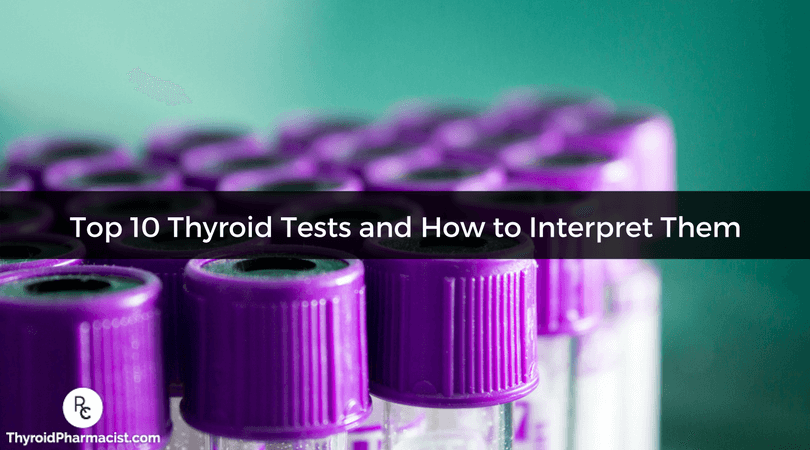
Top 10 Thyroid Tests and How to Interpret Them
Medically reviewed and written by Izabella Wentz, PharmD, FASCP
I spent almost a decade undiagnosed because I only had one marker tested. My thyroid condition was missed completely, leading me to deal with needless “mystery” symptoms like chronic fatigue, depression, anxiety, and many others, for far too long!
I still have a copy of my lab results from 2008, before I was diagnosed with Hashimoto’s. At that time, I was desperately searching for a reason behind my exhaustion, hair loss, anxiety, and digestive issues. According to this lab report, my TSH was at 4.5 μIU/mL, yet there was a note written from the doctor declaring: “Your thyroid function is normal, no need to do anything.” Perhaps a TSH of 4.5 μIU/mL would have been normal for a 95-year-old woman, but I was 25 and sleeping 12+ hours a night to feel rested!
Of course, even as a pharmacist, I didn’t think to question the doctor — and most people don’t.
If you suspect that you may have a thyroid condition, or know someone who does, this article will go over all of the most helpful tests that can help you identify a thyroid condition.
This article will also teach you how to understand your labs so that you can advocate for proper treatment for yourself.
In this article, I’ll go over:
- The top thyroid tests that I recommend
- How to interpret your results
- Understanding reference ranges
- How often you should test your thyroid
- How to use lab results for medication adjustments
Thyroid Tests 101
Testing thyroid hormone levels is the first step in diagnosing a thyroid disorder and determining the appropriate course of treatment. However, I’ve found that many doctors don’t test for Hashimoto’s, despite having their patients present with symptoms of thyroid disease.
Due to conventional guidelines, most primary care doctors simply test one’s TSH (thyroid stimulating hormone) and T4 levels (the amount of the T4 thyroid hormone circulating in your blood), to screen for hypothyroidism. However, these tests are not always interpreted correctly, don’t differentiate between non-autoimmune thyroid issues and Hashimoto’s, and often miss the subtle fluctuations of thyroid hormones and elevated thyroid antibodies that occur in the early stages of Hashimoto’s and hypothyroidism. These stages are often symptomatic and may last a decade before the TSH or T4 levels are flagged as abnormal. Sadly, from personal experience, conversations with other functional practitioners, and hearing reports from clients, I’ve often seen that people with these early stages of Hashimoto’s are told, “Your thyroid tests are normal, there’s nothing wrong with you”, even when they are clearly exhibiting symptoms of thyroid dysfunction that could be clearly confirmed by additional testing.
For this reason, it’s important to have a full thyroid panel done, which includes not only TSH and T4, but also T3, along with the two most common Hashimoto’s antibodies, TPO and TG antibodies. (When they are elevated, they indicate an autoimmune process within the thyroid gland. Their level can indicate the strength of the autoimmune attack against the thyroid gland and can help with predicting a timeline of full thyroid destruction.)
Additionally, an ultrasound test can help to diagnose Hashimoto’s, as well as reveal what’s happening with your thyroid and see if there are any nodules present.
I’ll go into detail about why each thyroid test is important below, but I do recommend getting a full thyroid panel done so that you have all of the information necessary to take charge of your health. [1]
Please be sure to review the bottom section of this article about lifestyle, medications, and supplements, as there are several other factors which may affect your thyroid test results.
Please note: The recommendations in this article are based on my clinical experience, and follow current research and recommendations by practitioners in functional medicine. They may not be recognized by doctors who are not familiar with functional medicine.
How to Order Your Lab Tests
If your doctor is ordering thyroid labs for you, be sure to request a copy so that you can see them for yourself and ensure that they are interpreted correctly.
Additionally, I have included self-order options for most of the labs discussed, in case your current doctor won’t order the labs for you.
The self-order options are discounted panels that I set up with Ulta Labs and can be ordered almost anywhere in the U.S. (direct access testing is prohibited by law in New York, New Jersey, and Rhode Island). You will receive a lab order that can be taken to your local lab, and the results will be sent to you electronically.
You can order each individual test that I recommend below, or you can order the entire discounted panel (TSH, free T3, free T4, TPO antibodies, TG antibodies) here.
In many cases, you can self-order the labs and then send the receipts for reimbursement to your insurance. (Please check with your insurance FIRST to ensure that they will accept this and what their procedure is.)
Now, let’s take a look at each thyroid test and what they mean for your thyroid health.
1. The Thyroid Screening Test
The thyroid stimulating hormone, or TSH test, is used as a screening test for thyroid disease, as well as a test for monitoring the correct dose of medication needed for an individual.
This is an important test that I recommend getting every time you check your thyroid function.
TSH is a pituitary hormone that responds to low/high amounts of circulating thyroid hormone. If you’re new to thyroid lab testing, it may seem counterintuitive, but an elevated TSH means that you do not have enough thyroid hormone on board and that you are hypothyroid. This is because the TSH hormone senses low thyroid levels and is released when there is a lack of it, in an effort to signal the body to make more.
In advanced cases of Hashimoto’s and primary hypothyroidism, this lab test will be elevated. In the case of Graves’ disease and hyperthyroidism, TSH levels will be low. People with Hashimoto’s and mild or central hypothyroidism may have a “normal” reading on this test.
If you’ve been a thyroid patient for a while, you’re probably thinking to yourself, “Well, of course, doesn’t everyone know that?” — and I have to warn you… I’ve unfortunately seen physicians who have mistakenly thought that a low TSH meant one had an underactive thyroid, and a high TSH, an overactive thyroid — putting their patients in really dangerous situations by under- or overmedicating them!
In recent years, The National Academy of Clinical Biochemists indicated that 95 percent of individuals without thyroid disease have TSH concentrations below 2.5 μIU/mL, and a new normal reference range was defined by the American College of Clinical Endocrinologists to be between 0.3 and 3.0 μIU/mL. [2]
However, in my experience of reviewing the labs of thyroid patients from around the world, many labs have not adjusted that range in the reports they provide to physicians, and some even have ranges as lax as 0.2 to 8.0 μIU/mL. Thus, conventional medicine practitioners will likely follow the standard reference range for TSH to determine if a person has hypothyroidism — in some cases, they may even follow a more lax range if the lab they are using hasn’t updated their levels, or if the practitioner is not familiar with newer guidelines.
In any case, physicians who follow “standard” reference ranges may end up telling their patients that their thyroid is normal, when in fact, they have a thyroid condition! And many physicians may miss the patients who are showing an elevated TSH. This is one reason why patients should always ask their physicians for a copy of any lab results.
Some practitioners consider a range of between 0.35 mIU/mL and 4.50 mIU/mL as normal, while others suggest using a range of between 0.5 mIU/mL and 2.50 mIU/mL as normal. [3] However, many of my colleagues in the functional medicine community, as well as myself, have further defined that normal reference ranges should be between 1 and 2 μIU/mL for a healthy adult not taking thyroid medications. And thus, for optimal health, a person with hypothyroidism should be properly treated until their TSH reflects that of a healthy person with optimal function. 🙂
When I was in Poland to find distributors for the Polish version of my first book back in 2014, I happened to visit one of my relatives who was wearing a heavy winter coat on a warm spring day. In speaking with her, I was able to tell that she was experiencing a great number of thyroid symptoms, and she confided that her doctor had said her thyroid was normal. I looked at her labs, and sure enough, her TSH was around 5 μIU/mL, and she was never tested for antibodies nor offered a thyroid ultrasound. (I often share that at the time of my diagnosis, I was living in Southern California and sleeping under two blankets, and was walking around with a TSH of 4.5 μIU/mL – and guess what, I survived living in Colorado for six years when my thyroid was optimized. :-))
I have found that I, as well as many other thyroid patients, feel best when my TSH is between 0.5 and 2 μIU/mL (for elderly clients, up to 2.5 μIU/mL). Some integrative professionals will go as far as to say that people should have a TSH of right around 1 μIU/mL or below 1 μIU/mL, to feel their best.
That said, the TSH test is not the only test that should be used to diagnose Hashimoto’s since, in the early stages, one’s TSH level may fluctuate or remain within the normal limits.
Most conventional practitioners will stop further thyroid testing when they determine the TSH is “normal” (that is, within the outdated, old school “normal” reference range).
This is why, even if you’ve been told your thyroid is normal, and even if your TSH is between 0.5 and 2 μIU/mL (the range I recommend), you need to test your free T4, free T3, and especially thyroid antibodies (TPO antibodies and TG antibodies), to truly determine if you have a thyroid condition.
Recommended test: TSH
Optimal reference range: Between 0.5 and 2 μIU/mL
How often you should test: Every four to six weeks when starting a new medication, then every six months if symptoms are stable.
Things to consider before testing: I recommend testing your TSH early in the morning, and delaying your thyroid hormones until after taking the test, to ensure accurate results, especially if you are taking T3-containing medications. Taking your medications before the test can suppress your TSH and make it look like you are overmedicated when you are not. Additionally, the supplement biotin, commonly used for hair loss, can also suppress TSH levels, making it look like you are overmedicated, or like you are hyperthyroid. The American Thyroid Association recommends that patients stop taking biotin for at least two days before a TSH test.
2. Thyroid Hormone Level Tests
There are four main thyroid hormones that have been identified: T1, T2, T3, and T4.
T4 (thyroxine) and T3 (triiodothyronine) are the two main thyroid hormones. T4 is known as prohormone and is 300 percent less biologically active than T3. T3 is the main biologically active thyroid hormone and gives us beautiful hair, replenishes our energy, and runs our metabolism. [4]
You may have put together that most of the commonly prescribed thyroid medications like Synthroid and levothyroxine, only contain T4 (thyroxine), and thus they need to be converted to the active T3 form in the body.
On paper, the T4 to T3 conversion happens just fine, but in the real world, in real human bodies, we may not always convert T4 to T3.
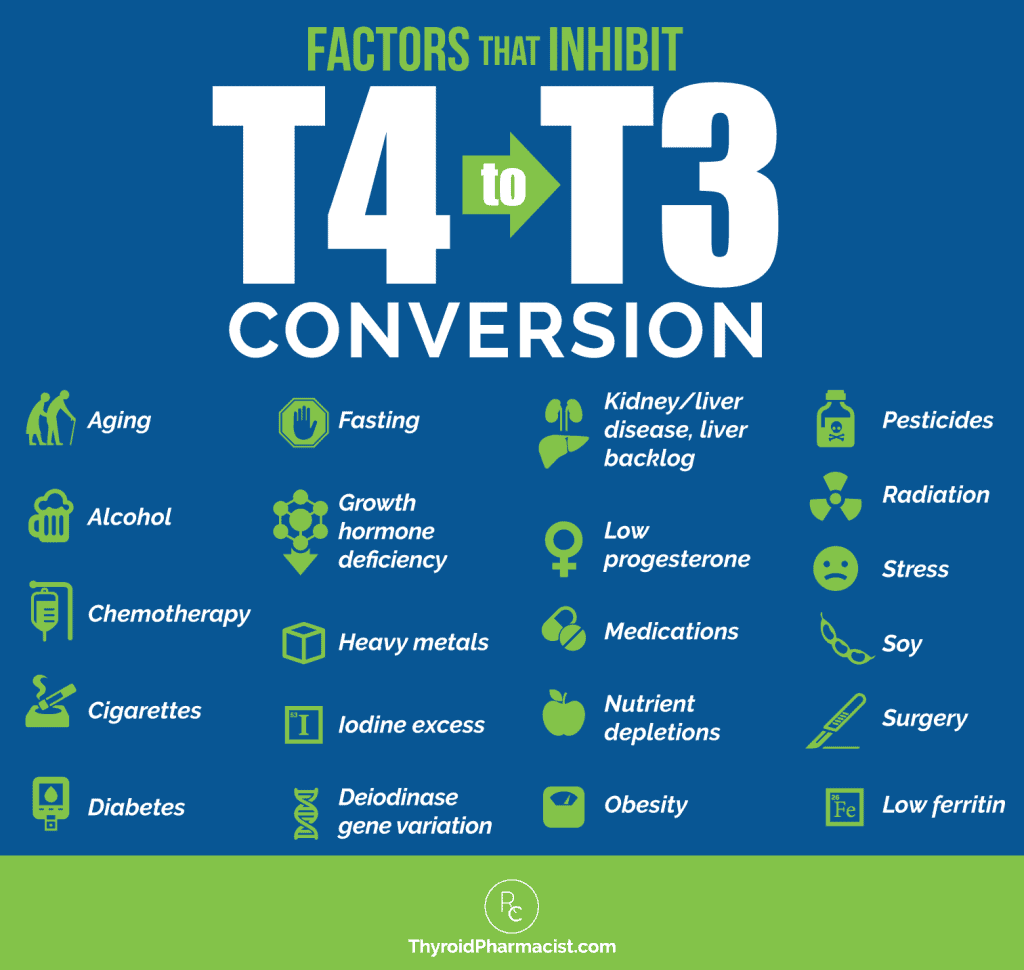
We can reveal our T4 to T3 ratios and measure the hormone that is available to do its job in the body, by testing our free T4 and free T3 levels.
Free T3 and Free T4 tests measure the levels of active thyroid hormone circulating in the body. (When these levels are low, but your TSH is in the normal range, this may lead your physician to suspect a rare type of hypothyroidism known as central hypothyroidism. I’m working on an article on this topic, so stay tuned!)
Some clinicians may only test for T4, but T3 is also important to test, as some individuals may not be converting T4 to the active T3 properly. Thus, people may have a normal T4, but a low T3 level.
How Do You Know If You Are Converting Correctly?
Take a look at your free T3 and free T4 levels. Both should be in the optimal ranges noted below, which have been determined by functional medicine guidelines and my clinical experience. If the T4 is optimal, but the T3 is below the optimal range, you know that your body is not making enough T3 hormone from the T4.
In rare cases, we may see low T4 levels and high T3. This is typically seen in pregnancy, when someone has an increased requirement for T4 and may benefit from adding extra T4 for the baby’s development. You can learn more about this in my article on pregnancy and Hashimoto’s. Outside of pregnancy, it’s not common to see low T4 and high T3.
Recommended test: Free T3 and Free T4
Optimal Free T4 reference range: 15 to 23 pmol/L
Optimal Free T3 reference range: 5 to 7 pmol/L
How often you should test: I recommend testing every four to six weeks when starting a new medication, every two to three months if tracking the impact of lifestyle changes, and then every six to 12 months once symptoms are stable.
Things to consider before testing: I recommend testing your free T3 and free T4 early in the morning, and delaying your thyroid hormones until after taking the test to ensure accurate results, especially if you are taking T3-containing medications. Taking your medications before the test can result in a falsely elevated T3 (and sometimes T4), making it look like you are overmedicated when you are not. Additionally, the supplement biotin, commonly used for hair loss, can also falsely increase both T4 and T3 levels, making it look like you are overmedicated, or like you are hyperthyroid. The American Thyroid Association recommends patients stop taking biotin at least two days before a T4 and T3 test.
3. Thyroid Antibodies
There are various types of antibodies against the thyroid gland that can be detected in thyroid disease. The presence of thyroid antibodies indicates that the thyroid gland has been recognized as a foreign invader by the immune system and that the thyroid gland is under attack.
In Hashimoto’s, triggers contribute to the body developing something called “a lack of self-tolerance.” This is when the body is no longer able to recognize its own tissue as part of itself, but instead starts viewing its tissue as a foreign invader. It is no longer “tolerant” of itself, and this is what leads to an autoimmune condition. When the body begins this breakdown of its immune tolerance, we’re initially going to see the presence of elevated thyroid antibodies.
In Hashimoto’s, about 80 to 95 percent of patients have thyroid antibodies. [5] Thyroid antibodies are going to be the first indication of a thyroid problem in many cases. They can be elevated for 5, 10, sometimes even 15 years, before a change in TSH is even detected. Having elevated thyroid antibodies, even in the presence of a “normal” TSH, means that it’s only a matter of time before your thyroid becomes destroyed to the point that it can no longer produce a sufficient amount of hormones.
Some clinicians will say that once you have thyroid antibodies, you will always have thyroid antibodies, so the actual number doesn’t matter, as the antibodies can randomly fluctuate. I respectfully disagree.
I believe that antibodies can fluctuate in response to triggers (some as common as stress), and in my exhaustive experience, they can be an incredibly helpful marker for tracking disease progression.
The most common antibodies in Hashimoto’s are thyroid peroxidase antibodies (TPO antibodies) and thyroglobulin antibodies (TG antibodies). Most people with Hashimoto’s will have an elevation of one or both of these antibodies. TPO antibodies are the most common and have been reported in 5 to 38 percent of the population, depending on the study! [6]
Thyroid antibodies are often elevated for decades before a change in TSH is seen in Hashimoto’s.
People with Graves’ disease and thyroid cancer may also have an elevation in thyroid antibodies, including TPO and TG. However, the most common antibodies found in Graves’ disease are TSH receptor antibodies, including thyroid-stimulating immunoglobulin (TSI) — this marker is elevated in over 90 percent of people with Graves’ disease. [7] TSH receptor binding antibody (TRAb), also known as TSH-binding inhibiting immunoglobulin or TBII, is elevated in over 50 percent of people with Graves’ disease. [8] (You can check for Graves’ related antibodies here.)
Thyroid antibodies can be used for diagnostic purposes and monitored to track remission. As I mentioned, thyroid antibodies indicate an active destruction going on against your thyroid. This destruction often comes with a lot of symptoms that may cause, or be misdiagnosed as depression, panic attacks, anxiety, miscarriage/infertility, carpal tunnel, hair loss, weight gain, fatigue/laziness, and, of course, the most disempowering diagnosis of them all… hypochondria.
Hypochondria is a diagnosis I take great offense to because it ignores the patient’s intuition that there is something wrong. It often leads to shame, disempowerment, helplessness, and the destruction of trust we have in our own mind and body connection, as well as in the healthcare model and of ever getting well.
The good news is that in many cases, when you have elevated antibodies and a normal TSH, you can not only reverse all of your symptoms, but you can also prevent damage to your thyroid gland using a root cause approach.
I found out I had thyroid antibodies in the 2000 IU/mL range, one year before doing a thyroid function retest, when my thyroid function deteriorated to the point where my doctor thought I would benefit from medications. Unfortunately, the doctor that initially ran the antibody test told me not to worry about them, and that there was nothing I could do anyway. I am often saddened that I trusted another person with my health and didn’t do additional research on my own. I was also highly symptomatic at that time, likely due to the elevated TPO antibodies. I had new onset panic attacks, social anxiety, hair loss, digestive issues, and fatigue — common early symptoms of elevated thyroid antibodies.
As a 25-year-old newlywed who had just moved to a new city, I was crippled by my health. Instead of focusing on being a newlywed, making my wedding albums, and meeting new friends, I felt like I was falling apart. The crazy thing is, I am now in my late 30s, with a busy little boy and a business, and I feel 10 times more energetic than I did in my 20s! I no longer grieve the decade I lost to undiagnosed Hashimoto’s, but this is why I’m so passionate about advocating for you to get the proper tests, and for you to understand your tests!
Thyroid antibodies may be elevated for many years before a change in TSH is seen, and finding antibodies early can often prevent damage to the thyroid, as well as help with preventing the need for long-term medications.
As mentioned earlier, thyroid antibodies can also be used as a marker to monitor disease progression and remission. While any elevation of thyroid antibodies can indicate Hashimoto’s (and some may have seronegative Hashimoto’s with thyroid antibodies not elevated at all), I like to monitor thyroid antibodies in clients.
While not all clinicians will agree to the following ranges, based on research and my clinical experience, here are the numbers I keep in mind:
- Thyroid antibodies above 500 IU/mL are considered a very aggressive case of Hashimoto’s
- Antibodies under 100 IU/mL indicate remission, or a less aggressive case
- Antibodies under 35 IU/mL mean you no longer test for Hashimoto’s according to conventional medicine standards
- Antibodies under 2 IU/mL are optimal (scientists believe that there may be some antibodies present as part of a normal repair process)
I recommend a lot of strategies to make the condition less aggressive and to put it into remission, in my article on reducing thyroid antibodies, as well as in my books Hashimoto’s: The Root Cause and Hashimoto’s Protocol. Be sure to check them out to learn how to lower your antibody levels.
Recommended tests: TPO, TG for Hashimoto’s (and TSI, TBII for Graves’). Please note that some TPO tests will only test up to 900 IU/mL, so if you know you have high levels of antibodies and would like a test that gives you more accurate numbers, be sure to check with the lab on their parameters before ordering. The TPO Antibody Endpoint test from Quest will give you TPO values beyond the 900 IU/mL limit, all the way up to 10,000 IU/mL, while the Thyroid Peroxidase Antibodies (TPO) version does not go above 900 IU/mL.
Optimal TPO reference range: <2 IU/mL
Optimal TG reference range: <2 IU/mL
Optimal TSI reference range: < 0.55 IU/L
Optimal TBII reference range: 16 to 100 percent inhibition of TSH binding
How often you should test: I recommend monitoring thyroid antibodies every 60-90 days to see if the changes you’re making in your lifestyle are helping you. A reduction in these antibodies, especially when accompanied by a reduction in symptoms, is a good indication that your condition is improving and that you are on the right path with your healing interventions.
4. The Thyroid Ultrasound
Some individuals may have thyroid disease but may not have detectable alterations in their blood work. In fact, research suggests that 10 to 50 percent of people with Hashimoto’s may not test positive for antibodies. [9] In these cases, a person might have a less aggressive version of Hashimoto’s known as antibody negative or seronegative Hashimoto’s.
In these cases, a thyroid ultrasound can be used to find physical changes in the thyroid gland that point to Hashimoto’s.
A thyroid ultrasound will help you and your physician determine whether you have changes consistent with Hashimoto’s (such as a rubbery thyroid, shrunken thyroid, enlarged thyroid, or abnormal growths in the thyroid that are present). Some growths may indicate an autoimmune process, others may indicate benign nodules, and others may signal cancerous nodules.
I can’t locate the reference at the moment, but I have learned that some 10 percent of people diagnosed with Hashimoto’s are diagnosed using an ultrasound, and I recommend that everyone with Hashimoto’s or thyroid disease get at least one ultrasound in their lifetime, especially women of childbearing age. If thyroid nodules are found, then I recommend having an annual ultrasound. (Be sure to read my comprehensive article on shrinking thyroid nodules if you happen to have them.)
A thyroid ultrasound is a very simple, non-intrusive test that only takes about 10 minutes. It uses sound waves to image the thyroid. A lubricant jelly is placed on the skin and a small hand-held transducer is passed over the thyroid. The ultrasound will show any change in gland size and texture. Clinicians can find changes in thyroid size (shrunken or enlarged), tissue density and texture (rubbery), as well as nodules (abnormal growths), which are all characteristic changes found with Hashimoto’s. Growths can also be a signal for cancerous nodules. If there is a concern with that, the next step would be to have a nodule biopsy, and you can read more about that in my article on thyroid cancer.
Recommended tests: Thyroid ultrasound ordered by your physician (I am not aware of self-order options at this time)
How often you should test: I recommend at least one ultrasound for every person, especially women of childbearing age.
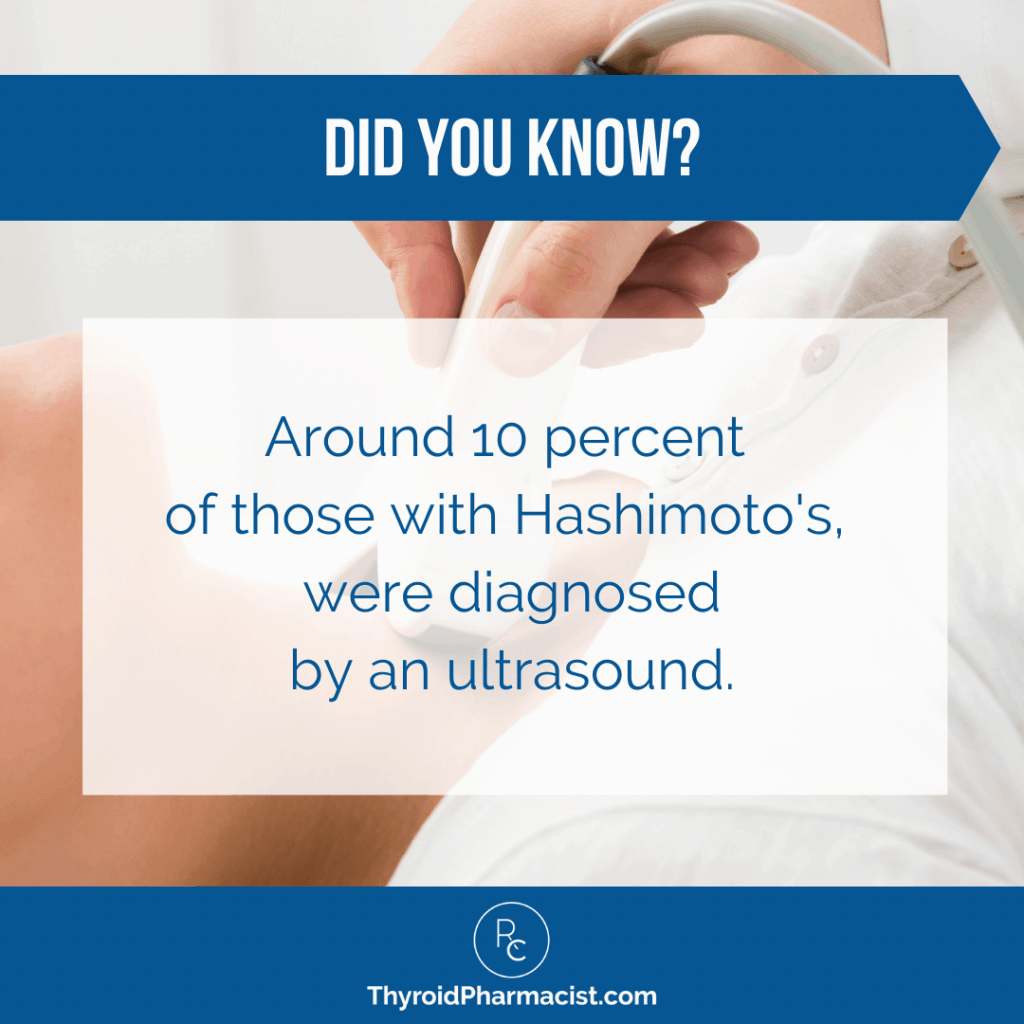
5. The Reverse T3 Test
The reverse T3 (rT3) test measures how much of the active free T3 hormone is able to bind at thyroid receptors. RT3 is produced in stressful situations and binds to thyroid receptors, but turns them off instead of activating them. (Stress is a common cause of low T4 to T3 conversion. Under stressful situations, T4 gets converted to reverse T3 instead of to T3. Reverse T3 is an inactive molecule related to T3, but without any physiological activity.) [10]
The rT3 test is sometimes used to identify cases of poor T4 to T3 conversion, as well as thyroid symptoms that are due to adrenal stress, instead of thyroid malfunction or autoimmunity.
However, in most cases, this test doesn’t change my other recommendations, so I consider this an optional test. (I prefer the adrenal saliva test to determine the proper treatment for adrenal stress. An adrenal saliva test gives us the advantage of knowing how to address the reason one is producing too much reverse T3.)
The free T4/free T3 test is more useful for me to determine if a person is properly converting thyroid hormones. In cases where a lot of reverse T3 is produced, adding a thyroid medication that contains T3 ensures that the right hormone is getting to the right receptors.
This test will likely not be used by conventional doctors, but many integrative doctors love the reverse T3 test, and it may be a useful test to monitor your improvement. So if you think that this test (or others listed here that are not part of a conventional assessment) might be useful for you, consult with a functional practitioner in your area. (I have a handy database of functional practitioners here on my website — but please note that I do not endorse or make representation as to the qualifications or business practices of any healthcare provider.)
When assessing your rT3 results, it is important to watch for trends of your levels going up. This usually indicates your body is reacting to a stressful situation. Your body produces rT3 to give it a break and to prevent you from becoming hyperthyroid. This is an evolutionary adaptation to slow your metabolism in times of famine (for more information on this, take a look at my Safety Theory). High rT3 due to stress has a snowball effect on hypothyroid symptoms. The adaptation by the body producing rT3 is not useful in our high-demand society when we must work and take care of our children, spouse, parents, etc.
Recommended tests: Reverse T3 (rT3)
Optimal rT3 reference range: Between 11 and 18 ng/dl
How often you should test: Every six months, if recommended by your integrative physician.
6. Your Symptoms
Last but not least, your symptoms should serve as an important thyroid test. Be sure to listen to your body — only you know its subtle messages!
Our symptoms offer vital clues as to what is going on inside our bodies, and these symptoms can shift as our thyroid hormone levels change.
Do you have any symptoms of hypothyroidism, or deficiency of thyroid hormone, such as:
- Slower metabolism leading to weight gain
- Forgetfulness
- Feeling cold or cold intolerance
- Depression
- Fatigue
- Dry skin
- Constipation
- Loss of ambition
- Dry, coarse hair
- Muscle cramps
- Stiffness
- Joint pain
- A loss of the outer third eyebrow
- Heavy menstrual periods
- Infertility
- Muscle aches
- Puffy face
- Slow heartbeat
- Brittle nails
- Arthritis
Or, do you have any symptoms of hyperthyroidism, or an overabundance of thyroid hormone, such as:
- Weight loss
- Palpitations
- Anxiety
- Eye-bulging
- Tremors
- Irritability
- Infrequent menstrual periods
- Fatigue
- Heat intolerance
- Increased appetite
- Hair loss
- Enlarged thyroid gland
- Sweating
- Frequent bowel movements
- Infertility
- Soft nails
- Warm, moist palms
- Finger tremors
- Insomnia
- Muscle weakness
- Nervousness
In addition to many of the symptoms we frequently see associated with hyper- and hypothyroidism, Hashimoto’s commonly presents with:
- Anxiety
- Depression
- Weight gain
- Mood swings
- Fatigue
- Brain fog
- Cold hands and feet
- Gastrointestinal issues
- Food sensitivities
Some of these symptoms may be directly related to insufficient thyroid hormone. Others may be due to related issues (i.e. gut infections), which I have seen in many people with Hashimoto’s. That’s why it’s important to identify the root causes of YOUR Hashimoto’s, so you can take the first steps toward healing!
Recommended tests: Create a health timeline and use a notebook or chart to keep track of your symptoms.
Reference Range: Score the severity of your symptoms from 1-10, and aim to steadily lower your score by uncovering and addressing your root causes.
How often you should test: I recommend assessing your symptoms on a weekly basis until you feel you have eliminated them.
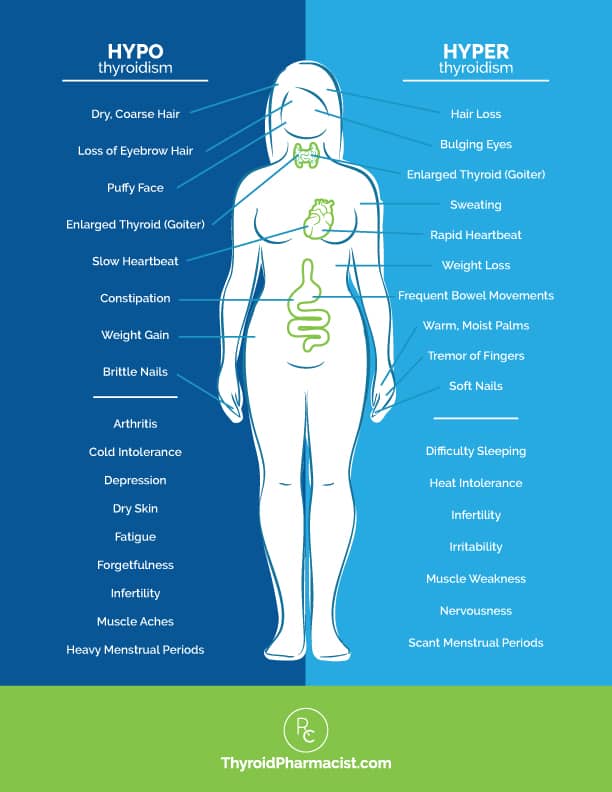
Interpreting Your Labs
Once you have your labs, what do you do with them? What do they mean?
I frequently get messages from readers asking me to comment on their thyroid labs. Of course, I can’t provide medical advice through the internet without doing a personalized comprehensive case review (this is for your own safety as well as due to professional liability laws), so I wanted to write this little guide for you all to empower you to understand your own labs.
Please note: This evaluation is based on optimal functional medicine ranges and my clinical experience, and may not be recognized by doctors who are not familiar with functional medicine.
Optimal Reference Ranges
When I look at my client’s labs, I’m focusing on optimal reference ranges. Here’s a handy reference chart I created for Hashimoto’s, based on recommendations from my training with the Institute of Functional Medicine:
The handy chart below explains what the thyroid lab numbers mean:
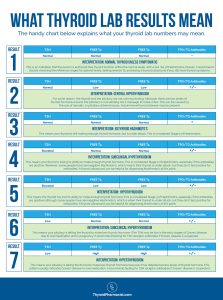
https://thyroidpharmacist.com/articles/top-10-thyroid-tests/
Know And Preserve Your Human Rights
A major concern with the current world scene is the speed with which human rights are being trampled.
This trend needs to be reversed. The entrance point is educating people that they do have rights.
If you do get that on which you put your attention, best we put our attention on what we want!
How many of human rights can you see under direct attack at present?
Freedom of thought?
Freedom of expression? (There are but two sexes.)
Freedom of movement? (15 minute cities.)
Right to assembly? (Right to protest outlawed.)
We are equal before the law? (Hunter Biden’s slap on the wrist for crimes attracting jail time for others.)
Watch these videos and if you think your human rights should be preserved, please share them.
Human Rights Video #1: Born Free and Equal
Human Rights Video #2: Don’t Discriminate
Human Rights Video #3: The Right To Life
Human Rights Video #4: Freedom From Slavery
Human Rights Video #5: Freedom From Torture
Human Rights Video #6: You Have Rights No Matter Where You Go
Human Rights Video #7: We Are Equal Before The Law
Human Rights Video #8: Protected By Law
Human Rights Video #9: No Unfair Detainment
Human Rights Video #10: Right To Fair Trial
Human Rights Video #11: Innocent Until Proven Guilty
Human Rights Video #12: Right To Privacy
Human Rights Video #13: Freedom To Move
Human Rights Video #14: Right To Asylum
Human Rights Video #15: Right To A Nationality
Human Rights Video #16: Right To Marriage & Family
Human Rights Video #17: Right to Ownership
Human Rights Video #18: Freedom of Thought
Human Rights Video #19: Freedom of Expression
Human Rights Video #20: Right to Assembly
Human Rights Video #21: Right to Democracy
Human Rights Video #22: Social Security
Human Rights Video #23: Workers Rights
Human Rights Video #24: Right to Play
Human Rights Video #25: Food and Shelter for All
Human Rights Video #26: Right to Education
Human Rights Video #27: Copyright
Human Rights Video #28: Fair and Free World
Human Rights Video #29: Responsibility
Human Rights Video #30: No One Can Take Away Your Human Rights

